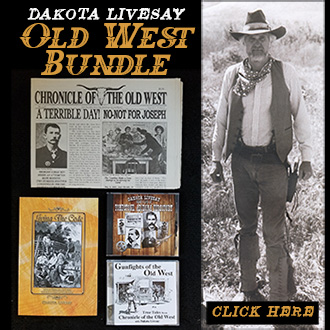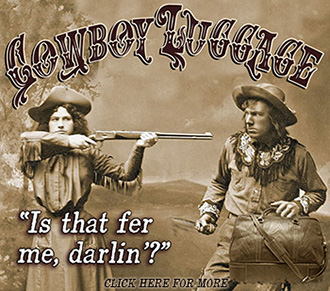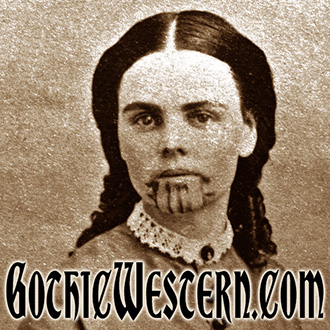Old West Book Review: The Frontier World of Fort Griffin
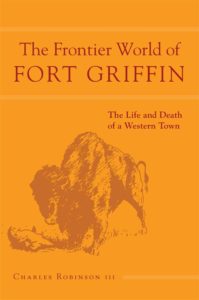 The Frontier World of Fort Griffin, Charles Robinson Ill, University of Oklahoma Press, 800-627-7377, $14.95, Paper. 236 Pages, Illustrations, Notes, Bibliography, Index.
The Frontier World of Fort Griffin, Charles Robinson Ill, University of Oklahoma Press, 800-627-7377, $14.95, Paper. 236 Pages, Illustrations, Notes, Bibliography, Index.
This fast-paced, fun to read book tells of the exciting, albeit short, life of the rip-roaring Texas town called Fort Griffin. Wild and dangerous, it sprouted from the desolate prairie to fulfill the needs of pioneers battling Indians, thus an army post was established. Next came buffalo hunters with hides to sell, then cowboys on cattle drives. Nicknamed “The Flat”, Fort Griffin was also known as “Hide Town”. The biggest settlement between Fort Worth and El Paso back in the 1870’s, it eventually dwindled into little more than a few stone foundations found today.
When the buffalo hunting days ended, and the great Indian raids ceased, the army moved out. The only real business for the town ended too when the great cattle drives no longer came through the area. Cattle were shipped by train, and into the late 1880s the land around Fort Griffin was slowly turned into small farms crossed by barbed wire fences.
Today, Fort Griffin does not exist as a town at all. But Western historians frequently come across stories about it as one of the wildest towns in the Old West. The author has delved through newspapers, court documents, and personal interviews to find the stories about what happened here.
It all started when the Republic of Texas was annexed to the United States in 1845. Next came a few hardy settlers demanding protection from marauding Indians. Protecting the early settlers came the Army, followed by ranchers with cattle raising ideas. More feuds, more fights, and eventually the buffalo hunters arrived decimating the great buffalo herds that provided sustenance for the Indians. Through all this Fort Griffin with its bustling activity naturally attracted gamblers, prostitutes, rustlers and gunmen who in turn were soon at odds with the local vigilance committee.
Rustlers and thieves were regularly hanged by night-riding locals seeking law and order, and sometimes revenge. Meanwhile, infamous people such as Henry “Doc” Holliday. Big Nose Kate, Pat Garrett, Lottie Deno, Wyatt Earp and a passel of lesser-known characters who were just as vicious and handy with guns came through town making plenty of trouble. Several chapters in the book are dedicated to downtown merchants, newspaper editors and the otherwise law abiding, but the real story concerning Fort Griffin seems to be about the tough, gritty, ambitious folks who were willing to shoot first and ask questions later.
This book is filled with odd and unusual characters who lived and sometimes died in Fort Griffin. For instance, Mrs. Lam drove a fast-moving buggy to town to try to save her husband from the vigilantes, but arrived too late. A man named Brock spent years traveling about the country trying to find a man he was accused of murdering in Fort Griffin because Brock wanted to clear his name.
Fort Griffin is compared with other tough towns such as Dodge City and Tombstone, but Fort Griffin was not to become a tourist town or a modern-day survivor. Only a few scraps of lumber and the walls of the Fort Griffin Lodge No. 489 remained in 1992 when this book was written. Each year locals gathered to celebrate the old town’s history filled with cowboys, buffalo hunters, soldiers, soiled doves, gamblers and vigilantes. Researchers will find that browsing through the various chapters will likely turn up some valuable information not easily found elsewhere. I discovered Glen Reynolds, a sheriff killed by Apaches in Arizona, had originally ridden at least one time with the vigilantes in Fort Griffin. This book is a little treasure for sure. It belongs in your Old West library.
Publisher’s Note: The reviewer, Phyllis Morreale-de la Garza, is the author of numerous books about the Old West including Death For Dinner; the Benders of (Old) Kansas, Silk Label Books, P.O. Box 700, Unionville, New York 10988-0700. Phone (845)-726-3434. Www.silklabelbooks.com
Old West Book Review: A Thousand Texas Longhorns
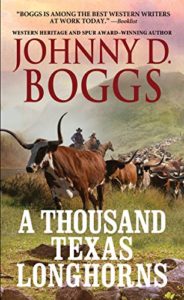 A Thousand Texas Longhorns, Johnny D. Boggs, Pinnacle Books Kensington Publishing, paperback, $8.99, 500 Pgs, Western Fiction.
A Thousand Texas Longhorns, Johnny D. Boggs, Pinnacle Books Kensington Publishing, paperback, $8.99, 500 Pgs, Western Fiction.
The time period for this novel is shortly after the American Civil War. The protagonist is a surly individual named Nelson Story living in a rough mining town in Montana Territory. Nelson Story wants to make money and become a successful rancher, and gets the brainstorm to acquire a herd of cattle lie must buy in Texas, and drive the herd back to Montana where the population is hungry for beef. So the adventure begins. He heads for Texas and prepares to drive a herd of longhorns all the way across the country filled with sheriff’s posses and angry homesteaders afraid the Texas cattle will bring fever to their own stock. Meanwhile Nelson Story has to maintain discipline among the drovers and freight wagon drivers, plus having to face electrical storms, driving rain, roaring rivers, drown cowboys, hordes of insects, cantankerous military commanders and Indians on the warpath.
Some of the cowboys are ex-Civil War veterans, both North and South. Two young women disguised as men sign on to drive freight wagons filled with goods for the trip. One is wanted for murder and both fool Nelson Story until one gets her clothing eaten off during a locust attack. Tired men commit mutiny, one cowboy dies in river, another is the victim of a rattlesnake, plus several others are brutally killed by Sioux stalking the herd hoping to rustle horses and beeves.
Nelson Story left a wife back in Montana when he skedaddled for Texas, and the book switches occasionally to what is going on with her as she anxiously awaits her husband’s return. She is pregnant when he departs, and must handle delivering and caring for a baby while keeping her meager household together. Her doctor fails in love with her although she remains faithful to Nelson Story, the author takes his readers from the gritty trouble-filled cattle drive to the desperately poor circumstances of a Montana mining town struggling to survive hard times, including a diphtheria epidemic.
Nelson Story eventually makes it to Montana with most of the herd, and there is a happy reunion with his wife who is nearly as tough as he is. Unfortunately readers never really get to know Nelson Story. He’s tough and determined, but rarely shows empathy or compassion that we can relate to. We never find ourselves cheering for his success. His quick temper and tough as nails attitude works to bring in the herd, but we never feel like we’d want to ride with him. Don’t look here for a John: Wayne or Matt Dillon hero. This story is mostly about grit and determination with little room for sentiment.
Author Johnny D. Boggs, a Spur Award winner, knows his business. Before writing this book, he followed the trail in an automobile to get the feel of the land, weather, and what it must have been like to cover all those hard miles on horseback. It is well told, with lots of realistic Old West action, and sometimes a tough book to read, but we find this story a good Western adventure for sure.
Editor’s Note: The reviewer Phyllis Morreale-de la Garza is the author of numerous books about the Old West, including Lost Roundup, published by Silk Label Books, P.O. Box 399, Unionville, New York, 10988, Ph. (845) 726-3434. www.silklabelbooks.com
Old West Book Review: Thunder in the West; The Life and Legends of Billy the Kid
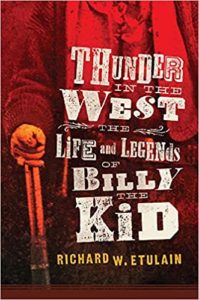 Thunder in the West; The Life and Legends of Billy the Kid, Richard W. Etulain, University of Oklahoma Press, $29.95, Non-fiction, Cloth. Illustrations, Photos, Essay on Sources, Bibliography, Index.
Thunder in the West; The Life and Legends of Billy the Kid, Richard W. Etulain, University of Oklahoma Press, $29.95, Non-fiction, Cloth. Illustrations, Photos, Essay on Sources, Bibliography, Index.
At various times he was called Henry McCarty, Kid Antrim, and Billy Bonney. However, most of us know him as Billy the Kid. This biography of the Western outlaw is carefully researched and well written in a style that keeps readers turning pages even though we have been exposed to this character via books and movies as far back as we can remember.
The author, Richard W. Etutain is the former Director of the University of New Mexico. He has had a long and important career as a writer and editor of more than 50 books pertaining to the American West. This book takes the reader on a journey beginning with Billy’s original birth place in New York in 1859. His mother moved west with young Billy and his one brother when the boys were children; it is not known who Billy’s father was. The family’s trait continued to New Mexico Territory, and the information includes the death of Billy’s kind, hardworking mother of consumption. Billy meandered after that from one situation to another.
Without real parental supervision or help, he drifted in and out of trouble, killed a man in Arizona before his 20th birthday, fled back to New Mexico ahead of a hot Arizona posse, and was arrested several times always managing to escape. Later, arrested for murders in New Mexico, he was jailed and awaited execution when he escaped again this time shooting and killing two sheriff’s deputies in Lincoln, New Mexico.
New Mexico politics comes into the life of Billy the Kid as he got mixed up in shoot-outs and became a gun-for-hire as various powerful political factions and wealthy land owners vied for power. In time, Billy ran with a gang of outlaws stealing horses and cattle.
Meanwhile, there were many people who considered Billy a good friend and many girls were attracted to him. He had friends in the Hispanic community, and spoke Spanish fluently. Eventually Billy was shot and killed by Sheriff Pat Garret inside a house in Fort Sumner, New Mexico in 1881.
Everything pertaining to Billy the Kid has some controversy involved. His birth, his little known family history, his mothers brief life, her marriage to a man who seemed to take no interest in his stepson, Billy’s involvement with politicians as well as land owners and desperadoes is all mired in controversy. As his fame grew, many people remembered him and wrote or talked about their relationships with him even many years after his death, thus adding to the intrigue.
The second part of the book delves into all the best-known books and movies featuring Billy the Kid. Etulain separates fact from fiction, complimenting those authors who have done serious and lengthy research. The movies featuring Billy the Kid are mostly contrived plots filled with fistfight action and gun battles. In the end we are still wondering why all the interest in a young, wayward character who even by modern standards would be known as little more than a dangerous juvenile delinquent.
This book takes the reader on a detailed, from beginning to end, Wild West journey featuring everything you ever wanted to know about Billy the Kid. It belongs in your Old West library.
Editor’s Note: The reviewer, Phyllis Morreale-de La Garza is the author of many books about the Old West, including Death For Dinner, the Benders of (Old) Kansas, Silk Label Books, P.O. Box 399, Unionville, New York 10988. www.silklabelbooks.com
Old West Book Review: Wrecked Lives and Lost Souls
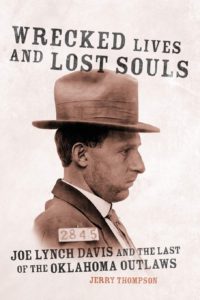 Wrecked Lives and Lost Souls; Joe Lynch Davis and the Last of the Oklahoma Outlaws, Jerry Thompson, University of Oklahoma Press, $24.95, Paper. Nonfiction, U.S. History, Illustrations. Maps, Notes, Bibliography, Index.
Wrecked Lives and Lost Souls; Joe Lynch Davis and the Last of the Oklahoma Outlaws, Jerry Thompson, University of Oklahoma Press, $24.95, Paper. Nonfiction, U.S. History, Illustrations. Maps, Notes, Bibliography, Index.
Born in 1891, Joe Lynch Davis was the second of five children born to Jack Davis and Bessie Satterwhite. The first part of this biography explains how the early Davis family migrated from northern Georgia to Oklahoma before the Civil War, accumulating land and becoming successful ranchers.
Jack Davis and his kin were tough people, allowing nothing to stand in their way of gaining vast amounts of cattle, horses, and other business interests through hard work. However, friends and neighbors were of the same cloth, and some of their endeavors were mixed with cattle rustling, horse theft, bank heists, train robberies and murder. In the midst of all this, Joe Lynch Davis, the main subject of this nook, grew into a tough young hellion good with guns and horses. By the time he was in his late teens he had already been involved in much of the mayhem. He seemed never to quell his enthusiasm whether in a roping contest at the local rodeo, or riding hard one step ahead of a sharp-shooting posse.
Joe’s family was mixed up in a Porum, Oklahoma feud that left more than 20 men dead. The Davis clan along with friends and enemies shot it out resulting in night-riding, arson, ambushes, missing persons, maimed bodies, and bloody folks getting even with each other by a variety of aggravated misunderstandings that end like all feuds do – with nobody knowing for sure what started it all.
During and after all this, young Joe was involved in one scrape after another quite fearlessly planning and carrying out cattle rustling, bank holdups and train robberies. Sometimes he and his gang pulled off more than one heist in one day. When occasionally Joe got caught and had to stand trial, he was let go by juries too scared of his family to find him guilty. Behind the scenes was Joe’s rich daddy who always found top-notch, high-priced lawyers to defend his son.
The book goes into detail about all the train and bank robberies, how much was stolen, and the aftermath. Somewhere along the way Joe met an attractive young lady named Lula Cobb, and together they had a little girl.
In 1917 Joe got caught after another train robbery that included the shooting death of a railroad employee. Railroad and Postal detectives this time got their man. Joe and his buddies did not get away with it. Joe did 17 years at Leavenworth Penitentiary, including several years in solitary confinement living on bread and water. The Davis family spent all their money hiring lawyers to free their son. Eventually President Herbert Hoover gave him a conditional commutation. Joe quietly returned to a desolate Oklahoma, ravaged by the Dust Bowl era’s Great Depression. His family was now poor, and Lula had been murdered years before by a violent and abusive husband who committed suicide.
Old and broken, in poor health, rebuffed by his family for having caused so much pain, Joe minded his own business, got a job, and never gave an interview. Joe died at age 86 in 1979. The author of this book is the son of Joe’s orphaned daughter. His interest in his grandfather was piqued when he found some old letters in a dresser drawer after his mother’s death. This led to years of painful research, thus readers feel the strength of his writing and depth of emotion, as he finds out about a grandfather whose outlaw life had been kept secret by the Davis family. Jerry Thompson is to be commended for his story, neither condemning nor defending a grandfather who was never part of his life.
Publisher’s Notes: The reviewer, Phyllis Morreale-de la Garza is the author of numerous books about the Old West, including Death For Dinner, the Benders of (Old) Kansas, Silk Label Books, P.O. Box 399, Unionville, New York, 10988. Ph. (845) 726-3434. www.silklabelbooks.com
*Courtesy of Chronicle of the Old West newspaper, for more click HERE.
Old West Book Reviews: Last Warrior
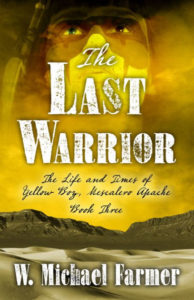 The Last Warrior, W. Michael Farmer, Five Star Publishing, $25.95, Cloth. Historical Fiction.
The Last Warrior, W. Michael Farmer, Five Star Publishing, $25.95, Cloth. Historical Fiction.
This is the third book in the series featuring the Mescalero Apache known as “Yellow Boy.” Earlier books in this series are Killer of Witches, and Blood of the Devil.
Yellow Boy lived sometime from 1860 through 1950, giving the author Michael Farmer an historical time frame through which the Mescalero Apaches survived the great changes brought upon them due to the arrival and domination of white men in the Southwest.
These Yellow Boy books are not only exciting, but help give readers an understanding of Apache culture. Their food, living conditions, beliefs and traditions are carefully woven into the stories. Some words in Apache are introduced, and fictional characters are mixed with some real people who lived during this time. Everything is carefully researched.
This third book is narrated by Yellow Boy himself as he tells his life story to another fictional character, Henry Fountain, who, as a child, had been rescued by Yellow Boy and has remained a close friend and ally of his Apache friend and teacher. While Henry listens, Yellow Boy explains about the most important adventures of his life dealing with both white people and various Apache enemies, plus some escapades that took Yellow Boy far into Mexico while having to deal with characters such as Pancho Villa.
Readers like Yellow Boy. He is not only a straight shooter in life, but a keen marksman having special Powers. A crack shot with his rifle, he is highly respected and carries great pride in the handling of firearms. He uses that to his advantage, but remains always fair in his dealings with friends as well as foe.
In this story Yellow Boy is determined to keep his family safe, while making necessary adjustments to their new life on a reservation. The story moves along quickly with good descriptions of the countryside, weather, animals, and all that is encountered during long rides through this unforgiving desert region.
We learn how a vindictive witch, who is the half-sister of the villain in a previous story, is determined to get even with Yellow Boy for having killed her murderous brother. This witch is nearly as bad as her brother and Yellow Boy must find a way to settle her hash. Her name is Ojo Verde, having one green eye and one brown eye. She plots the demise of Yellow Boy, cooking up all sorts of terrible revenge.
Of course Yellow Boy wins at the end of the story, but just when he is resting on his laurels and enjoying a peaceful smoke, there is more trouble on the horizon. Yellow Boy and both his wives hear talk about some missing friends. Supplies are short, and winter is coming on. It looks like Yellow Boy is in for yet another exciting adventure.
Stay Tuned.
Publisher’s Notes: The reviewer, Phyllis Morreale-de la Garza is the author of numerous books about the Old West, including Death For Dinner, the Benders of (Old) Kansas, Silk Label Books, P.O. Box 399, Unionville, New York, 10988. Ph. (845) 726-3434. www.silklabelbooks.com
*Courtesy of Chronicle of the Old West newspaper, for more click HERE.
Old West Book Review: Villa Lobos
 Villa Lobos, Michael Zimmer, Five Star Publishing, $25.95, Hardcover, Western Fiction.
Villa Lobos, Michael Zimmer, Five Star Publishing, $25.95, Hardcover, Western Fiction.
Author Michael Zimmer has written an action-packed, fast-paced western novel that will appeal to readers thirsty for tough adventure tales about the Old West. Sit back, read, and have fun with it, but don’t try to spend much time trying to figure out who all the characters are. The names are many.
The story titled Villa Lobos, means “Village of Wolves” giving an apt description of where this story is headed. You will find four groups of individuals riding south out of Texas and across the Rio Grande river where they are going to collide in a flurry of treachery, gun smoke, slashing knives, and dynamite.
The first group is made up of a gang of American outlaws who have just robbed a bank in Texas. Some people were killed, the town is in shock, and the gang now heads south where they plan to divide the loot. The leader is an ex-Confederate soldier named Hollister.
The second group consists of the American sheriff, leading a posse of adventuresome cowboys and townspeople who want their money back. The sheriff is an old hand at law enforcement and trailing felons, but desert heat and whining store keepers not used to riding with a posse slow him down.
The third group presents a half dozen soldiers escorting three runaway prostitutes back to the town they came from. The women are riding in a wagon, dressed as soldiers, and voicing more than their share of complaints as they plod along only to be ambushed and taken prisoners by the outlaw Hollister gang who seem to think the women will make valuable hostages in case the sheriff catches up. The surprised soldiers are embarrassed, and decide to go after the outlaws to get the women back.
Now the story presents a fourth group made up of Mexican bandits, cutthroats, liars and thieves. They are scalp hunters attacking Indian bands in Mexico for scalp bounty. They also take children and young women prisoners to be traded or sold deep in the Mexican interior as household servants, prostitutes and slaves. Known as “The Hunters” this outfit has not one individual that readers would care to-deal with. They headquarter in Villa Lobos, giving the town its name, and through murder and fear, control everybody. The leader is so vicious and corrupt we despise him instantly. (Remember The Magnificent Seven?) The old priest in town is the only person who escapes the bandit leader’s wrath.
By now, you have guessed you will have lots of names to wend through, but still there is no clear-cut protagonist whom we can cheer for, worry about, or hope he or she will come out on top. A character brave, respectable, wise, admirable, memorable, does not surface here. While we wonder why we are even reading this book, we find we cannot put it down. The action never stops, one shocking surprise after another finds us turning pages because we don’t want to miss anything.
The author has a good understanding of horses, guns, desert heat, the Spanish language, military procedure, historic Mexican villages, and the ability to put it on paper. Without a memorable protagonist the plot is shaky, but if you like western adventure stories, Villa Lobos will entertain you to the last page
Publisher’s Note: The reviewer Phyllis Morreale-de la Garza is the author of numerous books about the Old West including the novel Lost Roundup, published by Silk Label Books, P.O. Box 399, Unionville, New York 10988. www.silklabelbooks.corn
*Courtesy of Chronicle of the Old West newspaper, for more click HERE.
Old West Book Review: The Cornett-Whitley Gang; Violence Unleashed in Texas
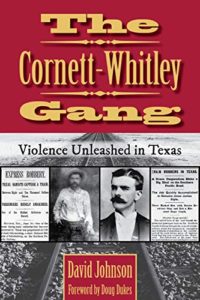 The Cornett-Whitley Gang; Violence Unleashed in Texas, David Johnson, University of North Texas Press, $29.95, Cloth. Non-fiction, 320 pages, Illustrations, Notes, Bibliography, Index.
The Cornett-Whitley Gang; Violence Unleashed in Texas, David Johnson, University of North Texas Press, $29.95, Cloth. Non-fiction, 320 pages, Illustrations, Notes, Bibliography, Index.
The time period for this book is the late 1880s, the location is Texas, and the topic is about a gang of train robbers. The names of these men are mostly unfamiliar to readers of today. None of them stood out above the rest in romantic familiarity. Don’t look for Butch and Sundance, or the James brothers. These men came together in a secret hide-away, made their plans, and then held up the trains. Afterwards they parted, at least for a while, and did a good job of fooling law enforcement. Some were married with children, most were solitary drifters who kept low profiles.
There were three important train robberies that made headlines. One at McNeal Station, another at Flatonia, and finally a third robbery at a place called the Verdigris Bridge. All three robberies were daring, well-planned, done ruthlessly and with precision. Some people got hurt, a few were killed, one lady passenger was pistol whipped for being too slow in turning over her valuables. Money and personal items were grabbed before the gang mounted up and disappeared into the darkness.
The book tells how law enforcement was blamed and even chided in newspaper accounts, embarrassed by the Media for their inability to catch the bad guys right away. The Texas train robberies made headlines all across the United States and even some foreign countries. Newspaper editors were certain all the bad publicity would be detrimental to the financial growth of Texas.
Law enforcement entities such as the Texas Rangers, federal marshals, railroad detectives and Wells Fargo eventually worked together sharing information until most of the robbers were caught. Some of this work remains in place even to this day. However, in the old days before computers and telephones, news about the robberies moved laboriously via telegraph, word of mouth or riders on horseback.
Letters at the back of the book contain personal accounts from various individuals who were involved in all this. Some romantic stories told were clarified. It seems a lot of people had a lot to say as the robbing of trains made big news. Eventually arrested, one robber, “Bud” Powell, alias John Thompson wrote a lengthy autobiographical account filled with original detail as he explains about some of his adventures after he left the gang. He traveled for several years evading the law and claimed he tried to “go straight.” Words coming directly from the outlaw give readers much to think about.
The author of the book, David Johnson has penned other important nonfiction books including John Ringo, King of the Cowboys; The Mason County “Hoo Doo” War, and The Horrell Wars. All of David Johnson’s books are well-researched, easy to read, and packed with plenty of information. If you are particularly interested in Texas train robbers, this book is for you.
Publisher’s Notes: The reviewer, Phyllis Morreale-de la Garza is the author of numerous books about the Old West, including Death For Dinner, the Bender of (Old) Kansas. Silk Label Books, P.O. Box 399, Unionville, New York, 10988. Ph. (845) 726-3434. www.silklabelbooks.com
*Courtesy of Chronicle of the Old West newspaper, for more click HERE.
Old West Book Review: Contention and Other Frontier Stories
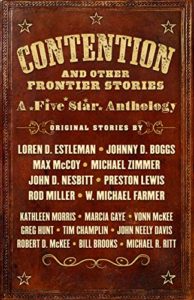 Contention and Other Frontier Stories: A Five Star Anthology of original Western stories by seventeen authors, Edited by Hazel Rumney, Five Star Publishing, $25.95, Cloth, Frontier Fiction.
Contention and Other Frontier Stories: A Five Star Anthology of original Western stories by seventeen authors, Edited by Hazel Rumney, Five Star Publishing, $25.95, Cloth, Frontier Fiction.
Most of the authors of these short stories are well-known winners of writing awards, having plenty of experience with word-wrangling. These stories are fast- paced, filled with original detail. Here you will find a wide selection of ideas and varied circumstances pertaining to our American frontier.
A good short story hooks the reader right away, and almost always ends with a surprise. The reader will arrive at the end and get a laugh, or perhaps be entertained when the villain gets his or her comeuppance. Nearly all of these stories live up to our expectations.
The editor is Hazel Rumney who began working for Thorndike Press in 1983. By 1995 Thorndike began publishing the Five Star western series, and soon the books began winning awards. Hazel Rumney was right in the middle of it all. She retired in 2011, but in 2012 Five Star called her back, offering her the job doing work from home, via computer. She grabbed the opportunity to edit in the comfort of her own home “drinking coffee” and avoiding travel; her dream job. Writers will tell you she is strict, she’s demanding, she looks for good stories that are exciting, believable, and true to Old West authenticity.
This collection has all the right combinations that make short stories work. The authors keep you guessing until the last page. Here you will find a deserter from Teddy Roosevelt’s Rough Riders; another is about a young ranch wife avenging the brutal and sudden murder of her husband; a wounded Pony Express rider brings in the mail during a blizzard; Geronimo sends one of his wives away to save her from life in captivity; a young cowboy and his sweetheart get even with a nasty gambler; a Mormon wife treks across the plains toward Utah, protecting her family even after her husband was killed; a tough old buffalo hunter stands firm in the face of removal from his home by encroaching civilization; two cowboys stranded in the mountains with a cantankerous old cook resort to cannibalism; a mysterious rider rescues two young girls held captive on a lonely ranch-far from town; a cocky young troublemaker finds himself involved in a shotgun wedding; a city girl newspaper reporter gets stranded in a dust storm, a miner tries a variety of imaginative ways to bury his dead partner, an aged colonel from Civil War days struggles with his memory; a preacher is embroiled in a Texas blood feud; a baseball player living in the past tries to avoid the reality of giving up the team; a young man with a speech impediment finds clever ways to defend himself.
These stories highlight protagonists with grit and imagination, who forge ahead against difficult circumstances. A variety of provocative issues are explored. These were tough people surviving tough times. This is good frontier fiction, a fun book to read.
Publisher’s Notes: The reviewer, Phyllis Morreale-de la Garza is the author of numerous books about the Old West, including Death For Dinner, the Benders of (Old) Kansas, Silk Label Books, P.O. Box 399, Unionville, New York, 10988. Ph. (845) 726-3434. www.silklabelbooks.com
*Courtesy of Chronicle of the Old West newspaper, for more click HERE.
Old West Book Review: Comanche Jack Stilwell
 Comanche Jack Stilwell, Clint E. Chambers and Paul H. Carlson, University of Oklahoma Press, $24.95, Paperback, Non-fiction, 288 Pages, 2 Maps, 26 Illustrations, Notes, Index, Bibliography.
Comanche Jack Stilwell, Clint E. Chambers and Paul H. Carlson, University of Oklahoma Press, $24.95, Paperback, Non-fiction, 288 Pages, 2 Maps, 26 Illustrations, Notes, Index, Bibliography.
When Arizona history buffs hear the name “Stilwell,” we immediately think of Frank Stilwell, killed by Wyatt Earp at the Tucson, Arizona train station in 1882. However, Frank had an older brother “Comanche Jack Stilwell” who led a far more productive and adventuresome life than his younger brother, but not in Arizona.
This book delves into the life and times of Jack Stilwell, beginning with his family history and looking into Jack’s running away from home in Kansas when he was thirteen years old. Unhappy about the separation of his parents due to his father’s infidelity, young Jack decided to head West with a freight outfit lumbering along the Santa Fe Trail. A family story says he went to the local water well where he met a group of lusty men with wagons filled with goods, and the boy signed on.
Thus began years of adventures first as a freighter crisscrossing the vast prairies, learning to speak Spanish as well as several Indian languages, including Comanche, earning him the nickname “Comanche” Jack. He eventually found work as a civilian scout for the U.S. Cavalry.
The Battle of Beecher Island comes up frequently in Stilwell’s biography. This event took place in September 1868 in northeastern Colorado. The fight lasted nine days between Cheyenne, Lakota and Arapaho warriors against soldiers of the Ninth Cavalry. During fierce fighting, Major Forsyth requested that Stilwell try to make the ninety-mile run for help to the closest army fort. On foot, draped in blankets, living on raw horse meat, Jack somehow got through enemy lines and is forever remembered as the hero of the Battle of Beecher Island.
Stilwell met Custer and scouted for him, was a friend of Buffalo Bill Cody, and knew many other famous westerners including Quanah Parker and Frederick Remington. Everyone seemed to like him, speaking and writing favorably about his willingness and good disposition. When his health began to fail he quit scouting and became a cowboy for several years.
In 1882 his younger brother Frank, who lived near Tombstone, Arizona was shot and killed by Wyatt Earp. Jack came to Arizona only long enough to settle his brother’s estate before returning home. With his health deteriorating badly, but still determined, he studied law, became a sheriff, and eventually a judge. Late in life he married a woman half his age.
His health continued to fail, and after a long series of painful issues related to his many years of hard outdoor living, he died February 17, 1903, probably of Bright’s disease. Today he lies buried at Old Trail Town, on the west side of Cody, Wyoming, and is remembered as a true Old West frontiersman.
This book goes into great detail about this man’s personal history, and is a fitting tribute to Comanche Jack Stilwell, “army scout and plainsman.”
Publisher’s Notes. The reviewer, Phyllis Morreale-de la Garza is the author of numerous books about the Old West, including Death For Dinner, the Benders of (Old) Kansas, Silk Label Books, P.O. Box 399, Unionville, New York, 10988. Ph. (845) 726-3434. www.silklabelbooks.com
*Courtesy of Chronicle of the Old West newspaper, for more click HERE.
Old West Book Review: According To Kate – Tale of Big Nose Kate
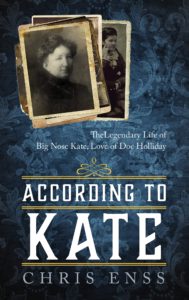 According To Kate, Chris Enss, Two Dot, $24.95, Cloth. Non-fiction, Photos, Notes, Bibliography, Index. This book chronicles for the first time the life story of Mary Katherine Horony, known as Big Nose Kate. Previously small parts of her life have been entwined with stories regarding her association with the Earps and Doc Holliday. If not for her relationship with Doc, it is likely that nobody would have heard of her, or even cared. Kate was a prostitute, a soiled dove, a lady of easy virtue who traveled throughout the rough Kansas cow-towns and mining camps in Arizona.
According To Kate, Chris Enss, Two Dot, $24.95, Cloth. Non-fiction, Photos, Notes, Bibliography, Index. This book chronicles for the first time the life story of Mary Katherine Horony, known as Big Nose Kate. Previously small parts of her life have been entwined with stories regarding her association with the Earps and Doc Holliday. If not for her relationship with Doc, it is likely that nobody would have heard of her, or even cared. Kate was a prostitute, a soiled dove, a lady of easy virtue who traveled throughout the rough Kansas cow-towns and mining camps in Arizona.
Her early life seems to have been stable. Her father was a doctor. She claimed to have had one early marriage and a child who died. However, she soon took up life on the wild side and stuck with it until old age caught up to her.
According to Kate, which is the title of this book, she hated the Earps and the nickname Wyatt bestowed upon her, “Big Nose Kate.” This name had little to do with the size of her nose, but because she stuck her nose into other people’s business. Kate and Wyatt contended for the attention and loyalty of Doc Holiday; Wyatt usually won.
After Doc Holliday’s death of tuberculosis in Glenwood Springs, Colorado, Kate married George Cummings, a mining man/blacksmith. In time she left this abusive drunk, and became a housekeeper at a tiny hotel in Cochise, Arizona. From here she became a housekeeper for Jack Howard, a mining man living in Dos Cabezas, Arizona. Thirty years later when Jack Howard died, Kate, nearly destitute was admitted to the Pioneer’s Home in Prescott, Arizona. She spent the last ten years of her life (to age 90) complaining about the food and accommodations white attempting to sell her memoirs to writers who might use the material for a book. There were no takers willing to give her money for her stories. Kate died at the Pioneer’s Home and is buried there.
This book is an accumulation of Kate’s lifetime adventures. Much of Kate’s story here is gleaned from a combination of her memoirs, some accurate and some not, plus the author Chris Enss’ having gathered historical facts from legal documents, census records, and newspaper articles.
Readers of this book should understand that Kate’s personal letters and memoirs have been picked over tong ago by Earpiana researchers. Nothing here is really new, but it is now well organized. There are only three photos of Kate in the book that are authentic. We have seen them long ago. A fourth shows an attractive teenage girl on the book cover, but it is hard to imagine this is really Kate. Mary Katherine Horony was not a pretty woman. She told some windies in her memoirs probably to help sell her story, but we can excuse an eighty-year-old lady for this. She had no idea that after her death legions of professional researchers would sift carefully through every facet of the lives and times of the Earps and their associates, including “Big Nose Kate.”
Author Chris Enss has done a creditable job accumulating information, both factual and fictional concerning a famous Old West figure who survived hard times; living to old age still feisty and determined to the end According To Kate is a fascinating read, worthy of inclusion in your Old West library.
Editor’s Note: The reviewer Phyllis Morreale-de la Garza is the author of numerous published books about the Old West, including 9 Days At Dragoon Springs, published by Silk Label Books, P.O. Box 399, Unionville, New York 10988. www.silklabelbooks.com.
*Courtesy of Chronicle of the Old West newspaper, for more click HERE.
Old West Book Review: The Ranger Ideal, Texas Rangers in the Hall of Fame
 The Ranger Ideal, Texas Rangers in the Hall of Fame, Volume 1, Darren L. Ivey, University of North Texas press $39.95, Cloth. 672 p.p., Photos, Notes, Bibliography, Index.
The Ranger Ideal, Texas Rangers in the Hall of Fame, Volume 1, Darren L. Ivey, University of North Texas press $39.95, Cloth. 672 p.p., Photos, Notes, Bibliography, Index.
For anyone interested in the history of the Texas Rangers, this book is a must read. It is the first of a three-book series telling about the lives of the most important men involved with the founding of the Texas Rangers. The time period it covers is from 1823 – 1861, and includes Stephen F. Austin, John C. Hays, William A. A. “Big Foot” Wallace, Samuel H. Walker, John S. Ford, and Lawrence S. Ross. All of these men have been inducted into the Hall of Fame and Museum at Waco, Texas.
The author points out in his Preface that several of these men are well-known, but the others have been mostly overlooked and do not have biographies or even extensive coverage in history books. All of these men are honored in the Texas Ranger Museum at Fort Fisher located near the Texas city of Waco. Visitors to the museum find Ranger displays including guns, clothing, saddles, equipment and artwork. The museum opened to the public in 1968, and continues its work educating the public about the important contributions Rangers made to Texas.
Readers find a timeline of Ranger history to help us better understand the enormous upheavals Texas went through beginning in 1821 when Americans established a colony on land that originally belonged to Mexico. Political changes are explained as Texas went from Mexican control to annexation to the United States in 1845.
Each of the seven men featured here were vastly patriotic, and did not hesitate to join in any and all of the fights, shoot-outs, military campaigns, long marches, sometimes capture and imprisonment in Mexico, and including every hardship imaginable. By the 1860s, two Rangers featured here joined the Confederate Army when civil war was declared and Texas went with the South. The battle records of these men are shown here, their adventures and derring-do included a multitude of battles and skirmishes reminiscent of Bruce Catton’s Civil War books where readers follow the amazing courage these soldiers displayed under the most difficult circumstances.
In 1860 Ranger John Ford was involved in the recovery of the highly publicized white woman Cynthia Ann Parker who, when still a child, was taken captive by Comanches. By the time she was rescued years later, she had mostly forgotten her white way of live, and even how to speak English.
Of the seven Rangers featured in the book, only three ever married while the others seem to have dedicated their lives to Texas. Two of these men died fighting.
The author has done an impressive job of researching for truths related to this material. Anyone looking for information about the Texas Rangers will find this tome invaluable.
Darren L. Ivey is to be commended for his good writing and careful research into an important topic about the American West. In addition to The Ranger Ideal, Texas Rangers in the Hall of Fame his writing includes a previously published book on this subject titled The Texas Rangers; A Registry and History.
Thus far, thirty-one individuals have been honored in the Texas Ranger Hall of Fame. If you are a Texas Ranger fan, you will want this one for your Old West library, and will look forward to reading the next two books in the series.
Editor’s Note: The reviewer Phyllis Morreale-de la Garza is the author of many books including Death For Dinner; The Benders of (Old) Kansas, published by Silk Label Books, P.O. Box 700, Unionville, New York, 10988-0700. Ph. (845) 726-3434. www.silklabelbooks.com
*Courtesy of Chronicle of the Old West newspaper, for more click HERE.
Old West Book Review: Nighthawk Rising
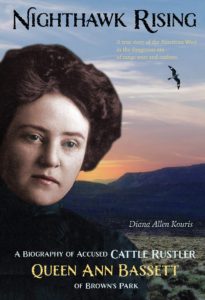 Nighthawk Rising, Diana Allen Kouris, High Plains Press, $19.95, Paperback 416 pp, Photos, Maps, Notes, Bibliography, Index.
Nighthawk Rising, Diana Allen Kouris, High Plains Press, $19.95, Paperback 416 pp, Photos, Maps, Notes, Bibliography, Index.
Nighthawk Rising is the fascinating story is the biography of “Queen” Ann Bassett, an accused cattle rustler living in Brown’s Park in the 1880s through the turn of the century. Brown’s Park is a wildly beautiful area spanning the rugged mountains throughout western Utah, southern Wyoming, and eastern Colorado. This is the land of the Wild Bunch, Butch Cassidy, the Sundance Kid, deadly range wars and Tom Horn.
Ann Bassett’s parents settled here, trying to make a living in the difficult cattle business. Ann’s mother ruled the roost, a tough woman who rode sidesaddle while directing her cowboys. Ann’s father was a quiet gentleman more likely to be found at home writing poetry.
Ann and her three siblings grew up learning self-sufficiency. The little girl was a tough cookie, riding the most spirited broncs, and refusing sidesaddles. She dressed in buckskin trousers, was a top hand with a lariat, and could handle guns. Headstrong and resisting discipline, as a teenager she roped a grizzly cub and got her horse killed when mama bear came to the rescue. Ann got a well-deserved spanking from one of the cowboys who saved her life, but even that did not deter the girl from adventuresome deeds. She was always in the middle of things, whether driving cattle in a snow storm or crawling into a cave to kill coyote pups.
Sadly, Ann’s mother died suddenly of appendicitis. It now fell on Ann to be a leader in the family. These changes in the girl’s life coincide with the range war sweeping through Brown’s Park as the big ranchers tried to rid themselves of competition from smaller outfits. Tom Horn was hired as a “range detective”. Unsolved murders occurred thereafter, including the shooting death of Mat Rash, a handsome young cattleman who dated Ann Bassett and was destined to become her husband until his bullet-riddled body was found in the hills, most likely murdered by Tom Horn.
This tragic loss undoubtedly shaped Ann’s personal life thereafter. She never had a young husband. She had several husbands, all older men, and divorces. Her life seemed forever in turmoil in her effort to protect her ranch way of life. She moved from one place to another, was involved in legal disputes, was accused of being a “”rustler”, and nicknamed “Queen Ann” because of her rebellious nature.
Don’t look here for a hard riding bandit queen leading a gang of outlaws. Ann’s day by day life shows a gritty woman determined to survive against powerful men and forces beyond her control.
Diana Allen Kouris, the author of Nighthawk Rising, herself grew up in the Brown’s Park region. Her family is in the cattle business. Even though she was born many years after Queen Ann rode the range, Kouris has been able to relate to Brown’s Park and the people. Her writing is filled with original detail. We detect the author really knows what she is writing about, generating a feeling of respect and empathy for Queen Ann when readers turn the last page: a truly haunting story.
Publisher’s Notes: The reviewer, Phyllis Morreale-de la Garza is the author of numerous books about the Old West, including Death For Dinner, the Benders of (Old) Kansas, Silk Label Books, P.O. Box 399, Unionville, New York, 10988. Ph. (845) 726-3434. www.silklabelbooks.com
*Courtesy of Chronicle of the Old West newspaper, for more click HERE.
Old West Book Review: Health of the Seventh Cavalry; A Medical History
 Health of the Seventh Cavalry; A Medical History, Edited by P. Willey and Douglas D. Scott, University of Oklahoma Press, (405) 325-3200, $3295, Cloth. 480 Pages, Illustrations, Maps, Graphics, Charts, Bibliography, Index.
Health of the Seventh Cavalry; A Medical History, Edited by P. Willey and Douglas D. Scott, University of Oklahoma Press, (405) 325-3200, $3295, Cloth. 480 Pages, Illustrations, Maps, Graphics, Charts, Bibliography, Index.
Persons interested in the life and times of members of Custer’s Seventh Cavalry will find this book a treasure trove of information pertaining to the health of these soldiers.
The time period covered is 1866 through the early 1880s. The first chapter talks about the Regimental history of the Seventh, beginning at the end of the Civil War. At this time the Seventh began moving westward to deal with hostile Indians of the Plains. Of course anything to do with the Seventh Cavalry must include information about General George Armstrong Custer, eventually leading to the Battle of the Little Big Horn.
But long before the Little Big Horn, in July 1866, Seventh Cavalry troops were assembling at Fort Riley, Kansas. From here they were dispersed toward the western Plains from Ft. Riley and beyond. One table in the book shows the Seventh Cavalry company assignments by year all the way to 1882.
The authors give detailed descriptions of the various living quarters, expeditions, care of horses, weather conditions and the like. There is one particularly sobering photograph of the arrow-riddled Sergeant Frederick Wyllyams of Company G where he was murdered and mutilated by hostile Indians in 1867.
Always the book’s focus is on the health of the soldiers from information gleaned from, medical records as well as personal accounts written by those who lived and traveled with the troops. Occasionally we hear from Elizabeth Custer and a few other wives as they described weather conditions, injuries, epidemics, living quarters and social events within the forts.
The men of the Seventh were attended by military physicians who had been doctors during the Civil War. A list of their names and dates they served is included here. They treated insect and snake bites, gunshot wounds, venereal disease, horse- related injuries, results of bar brawls, frostbite and contagious diseases such as cholera. The lists include everything from lacerations to mumps. These doctors were also expected to treat civilians who worked at the forts that included officers’ wives and children, and laundresses.
Military doctors were not always looked upon with respect, behind their backs some were referred to as “Pills” and other uncomplimentary nicknames. However, some surgeons such as Assistant Surgeon Leonard Wood earned the Medal of Honor for carrying dispatches through hostile Indian Territory during the 1886 campaign against Apaches in Arizona. Wood was later credited with discovering the cause and treatment of yellow fever.
Eventually the reader arrives at the Battle of the Little Big Horn, and much information is gleaned through forensic examination of the remains of the men who died with Custer. Extensive examination of bones and teeth reveal many physical ailments the men suffered throughout their lifetimes, and including whenever possible wounds received on the battlefield that led to their deaths.
At the end the authors declared the men of the Seventh were “neither the unsoiled, healthy heroes represented by Errol Flynn in They Died With their Boots on, nor the maniacal one-dimensional soldiers portrayed in Little Big Man”. One observer in the old days described the Seventh Cavalry as “good fighters but mostly heavy drinkers.’
And so be it. They rode with Custer. May they rest in peace. This unique book has everything you’ve ever wanted to know about the health of those brave fighting men. The book belongs in your Old West library.
Editor’s Note: The reviewer, Phyllis Morreale-de Ia Garza is the author of numerous books about the Old West, including the true crime Death For Dinner, The Benders of (Old) Kansas,, published by Silk Label Books, P. Box 700, Unionville, New York, 10988-0700 www.silklabelbooks.com
*Courtesy of Chronicle of the Old West newspaper, for more click HERE.
Old West Book Review: Dark Territory, A Sheriff Aaron Mackey Western
 Dark Territory, A Sheriff Aaron Mackey Western, Terrence McCauley, Pinnacle Books, $7.99, Paperback. Western fiction.
Dark Territory, A Sheriff Aaron Mackey Western, Terrence McCauley, Pinnacle Books, $7.99, Paperback. Western fiction.
This second book in the Aaron Mackey series finds Mackey once again keeping law and order in his old Montana home town of Dover Station. This time a group of investors have descended upon the town with an eye on taking over the business interests of this booming community. Mackey determines to defend his town, friends and relatives from those who are devious and have selfish interests in the local mining ranching, and railroads.
Shootouts, bad actors, murder, skullduggery and unresolved love interests all present a myriad of problems to be solved by the sheriff. By now readers have become used to his hair-trigger temper and no-nonsense demeanor, and we can only wonder what will come next in the life of this hero if there is a Book Three.
Editor’s Notes: The reviewer Phyllis Morreale-de la Garza is the author of numerous books about the Old West including the novel, Nine Days at Dragoon Springs, published by Silk Label Books, P.O. Box 399, Unionville, New York 10988 www.silklabelbookscom
*Courtesy of Chronicle of the Old West newspaper, for more click HERE.
Old West Book Review: Where the Bullets Fly, A Sheriff Aaron Mackey Western
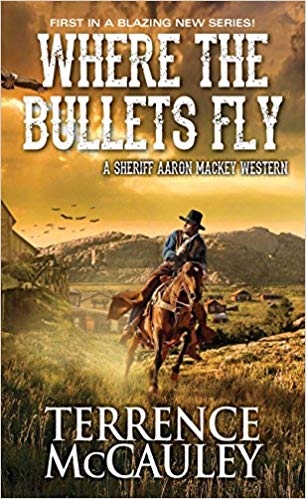 Where the Bullets Fly, A Sheriff Aaron Mackey Western, Terrence McCauley, Pinnacle Books, $7.99, Paperback. Western fiction.
Where the Bullets Fly, A Sheriff Aaron Mackey Western, Terrence McCauley, Pinnacle Books, $7.99, Paperback. Western fiction.
The first book in the Sheriff Aaron Mackey series, this story introduces readers to Aaron Mackey, the sheriff of Dover Station in Montana Territory. Mackey is an ex- cavalry officer, now sheriff. His deputy is a black man who once rode with him in the cavalry. Together, these men try to keep law and order, but when a crazy outlaw named Duramont, leading a band of killers, appears on the scene, Mackey has more than his share of trouble.
Dover Station is surrounded by the Duramont gang, a group of “soiled doves” become Duramont’s hostages along with Mackey’s mistress, who owns the local hotel. The outlaws need guns, horses and supplies while they are on a ride through the west, murdering and robbing along the way. Mackey must rely on a few faithful buddies for help since most of the townspeople understandably want to be left alone without losing their hides. Meanwhile, Mackey’s wife, a beautiful young shrew who hates him, finds out about his mistress and the plot thickens.
Between the killers, the robbers, nighttime ambushes, flying dynamite, burned buildings, runaway stagecoaches and feuding women, the sheriff has more than his hands full. And did I mention he is in the middle of all this while battling pneumonia?
If you like plenty of western action, this is the book for you.
Dark Territory, A Sheriff Aaron Mackey Western, Terrence McCauley, Pinnacle Books, $7.99, Paperback. Western fiction.
This second book in the Aaron Mackey series finds Mackey once again keeping law and order in his old Montana home town of Dover Station. This time a group of investors have descended upon the town with an eye on taking over the business interests of this booming community. Mackey determines to defend his town, friends and relatives from those who are devious and have selfish interests in the local mining ranching, and railroads.
Shootouts, bad actors, murder, skullduggery and unresolved love interests all present a myriad of problems to be solved by the sheriff. By now readers have become used to his hair-trigger temper and no-nonsense demeanor, and we can only wonder what will come next in the life of this hero if there is a Book Three.
Editor’s Notes: The reviewer Phyllis Morreale-de la Garza is the author of numerous books about the Old West including the novel, Nine Days at Dragoon Springs, published by Silk Label Books, P.O. Box 399, Unionville, New York 10988 www.silklabelbooks.com
*Courtesy of Chronicle of the Old West newspaper, for more click HERE.
Old West Book Review: Valley of the Guns
 Valley Of The Guns, Eduarado Obregôn Pagan, University of Oklahoma Press, $29.95, Cloth. Maps, Illustrations, Photos, Notes, Bibliography, Index.
Valley Of The Guns, Eduarado Obregôn Pagan, University of Oklahoma Press, $29.95, Cloth. Maps, Illustrations, Photos, Notes, Bibliography, Index.
“Pleasant Valley” conjures up images of warm summer evenings, horses quietly munching hay in the corral, Mom and Dad laughing quietly on the porch while kids play with a favorite pet lamb. But don’t be fooled. Pleasant Valley was only a name.
The location is northern Arizona below the Mogollon Rim, made up of rough, mountainous country near Indian reservations and a long way to town. Men of derring-do pioneering spirit, determined to find success in a world of sprawling cattle and mining opportunities settled here. Some brought wives with them, while most came alone. They built sturdy one-room cabins compete with gun ports in the log walls. Roving Apaches, sometimes fleeing the nearby reservation skulked amid the tall trees while coveting white man’s supplies and horses.
The late 1880s saw these settlers always on the lookout for trouble, while determined to make a good life. Folks settling in the area soon made friendships and alliances with neighbors. A long way from law enforcement, they learned to band together to protect one another.
However, a series of misunderstandings, revenge and stubborn pride led to the violent deaths of eighteen men, four seriously wounded, and one man missing. The leading families involved were the Grahams and the Tewksburys. The Tewksburys were Arizona natives with an Indian mother and white father. The Grahams, originally from Iowa, like many young men of that era, decided to head “west” eventually meeting the Tewksburys in Pleasant Valley, Arizona.
The author of this book does a careful background search into the lives and origins of both these families and their friends. He delves into their history, what made them act and react to situations resulting in the Pleasant Valley War. Over the years many historians have suggested the conflict was between sheep men and cattlemen, but this is not exactly true. While the Grahams specialized in raising horses, the Tewksburys had both cattle and sheep, and at times shared grazing land with not only the Grahams, but others in the valley that had both cattle and sheep. Many families helped one another in their quest to protect themselves from both rustlers and Apaches, thus the exact cause of the feud is hard to pin down.
What is known is that a lot of men died. There was great fear in the community as even vigilantes and night riders took to the trails. One by one, men died violently, while friends and relatives got revenge. There was even the ghastly lynching of three young ranchers whose bodies were left dangling from a tree for many days as a warning to others who might consider stealing cows.
This book is easy to read, written in a style designed to inform as well as keep the reader turning pages. The author digs into the underlying causes of fear, revenge, guilt, anger and hatred. Blood feuds always result in senseless tragedy, and when they end, nobody seems able to remember what really started it all. The author explains how humans react naturally during moments of grave danger. We either fight, flee, or freeze. We don’t know what we will really do until actually confronted with the emergency that requires instant decision.
Fear, murder and revenge rode those mountain trails. The author of this book has done a creditable job of bringing the story of the Pleasant Valley War to life. He has weeded through all the controversy, explains what happened to all of the participants of the conflict, and leaves the reader with much to ponder after turning the last page. This is a good addition to your Old West library.
Editor’s Note: The reviewer, Phyllis Morreale-de la Garza is the author of numerous books about the Old West including Nine Days at Dragoon Springs, published by Silk Label Books, P.O. Box 399, Unionville, New York ,10988. www.silklabelbooks.com
Old West Book Review: You Are Respectfully Invited to Attend My Execution
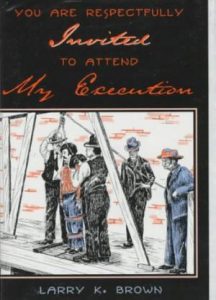 You Are Respectfully Invited to Attend My Execution, Larry K. Brown, High Plains Press, (1-800-552-7819), $11.95, Paperback.
You Are Respectfully Invited to Attend My Execution, Larry K. Brown, High Plains Press, (1-800-552-7819), $11.95, Paperback.
Between 1871 and 1890, seven murderers were hanged in Wyoming Territory. Some others died (including one woman) in Wyoming at the hands of angry mobs, known as vigilantes. However, this book concentrates on the seven legal executions.
Author Larry K. Brown has sifted through court documents, family histories, newspaper articles, and historic journals. An astute observer of human nature, Brown’s research is aimed at presenting a chilling picture of each crime, both victim as well as perpetrator, the arrest, trial, incarceration and finally the last steps of the condemned as they mounted the scaffold.
There are no happy endings here for the victims or the killers. Murder is murder. The victim’s life ends suddenly and brutally, while the killer’s own days are then numbered whether they want to believe it or not. We, students of Old West history, are left trying to understand what leads a person to carry out such evil deeds while thinking they will escape the consequences.
Wyoming Territory from 1871 to 1890 was filled with adventurers, trappers, hunters, homesteaders, ex-military men packing iron, and sometimes shady individuals who experienced hard times and long waits between meals. While some looked for work, others looked for trouble and a fast dollar. The author explains in his introduction the purpose of the book, giving a brief history of capital punishment, its purpose and methods. Whether the reader agrees or disagrees with capital punishment, this fascinating little book gives insight into the Old Western laws and how people dealt with this problem in the building of the new nation.
Wyoming Territory had to find ways to enforce law and order to encourage new settlement. Highwaymen, cattle rustlers and horse thieves were unwelcome. Drifters were not encouraged to stay long. Seven men committed atrocities that led them to the gallows, and they paid with their own lives.
John Boyer shot and killed two men for raping his mother and sister. William “Tousant” Kensler shot a man while the two argued over a prostitute. John Leroy Donovan beat a barber to death while the man slept, then stole his life savings. George Cooke shot and killed his brother-in-law during a drunken argument. John Owens killed a man with an axe for the purpose of stealing his money. Benjamin Carter was a bully who beat up, then shot a young cowboy during a cattle drive. George Black shot an old hermit inside his cabin over a land dispute.
Once caught, some of these men admitted their deed, others denied it; all hoped for last-minute reprieves. Asking forgiveness, too late they craved comforting words from loved ones they had not considered when they turned to murder. Punishment in the Wyoming Territory was swift, the executions were carried out within a short time after sentencing. The author follows each man’s thoughts and actions all the way to their last meal and beyond.
This is not a book you should read before going to bed at night! It is less than 200 pages, but will cause readers to reflect upon choices we make, and the responsibility people must take for their own actions. The reader is left to ponder what really lurked inside the hearts and minds of these killers as they acted upon their baser instincts. For us, these stories should be lessons learned.
Editor’s Note: The reviewer, Phyllis Morreale-de la Garza is the author of numerous books about the Old West including the non-fiction book about the Arizona outlaw titled The Apache Kid, published by Westemlore Press, P.O. Box 35305, Tucson, Arizona 85740.
*Courtesy of Chronicle of the Old West newspaper, for more click HERE.
Old West Book Review: My Ranch, Too
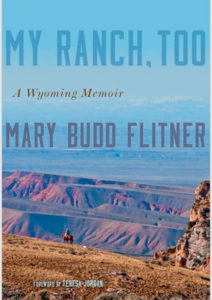 My Ranch, Too. A Wyoming Memoir, Mary Budd Flitner, University of Oklahoma Press, $24.95, Cloth. 2 maps, 23 Photos, 232 pages.
My Ranch, Too. A Wyoming Memoir, Mary Budd Flitner, University of Oklahoma Press, $24.95, Cloth. 2 maps, 23 Photos, 232 pages.
There are not many books that I read twice, but My Ranch, Too is one of them. If you have ever lived on a ranch, or handled horses, dogs, cattle or sheep, or even thought about it, you will smile at the author’s astute observations, and wonderful way of describing it all.
Mary Budd Flitner’s great grandfather Daniel Budd, settled in Wyoming Territory in 1878. He inherited a herd of cattle from his brother who died unexpectedly at a young age. Budd moved his family from Kansas to Wyoming, and thus began the story.
Today, great granddaughter Mary Budd Flitner owns and operates a large cattle ranch in Wyoming, known as the Diamond Tail Ranch. Her husband Stan is also a descendant of a Wyoming ranch family. The land, weather cattle, horses and sheep are part of their heritage. Mary’s wonderful stories are written chapter by chapter filled with original detail. Every experience imaginable having to do with Wyoming ranch life is described with clear and careful thought.
Readers will enjoy her subtle sense of humor in chapters like the horse race, and the disappearance of her children’s bum lambs. Things usually turn out for the best with happy endings, although Mary is fair and tough when circumstances require a firm hand. Her dealings with horses, cowboys, hired and amateur helpers, terrible cold winters and seasons of drought are part of her life. Raising four kids through thick and thin, high interest rates and livestock losses are dealt with head-on.
Mary Flitner’s great love for her land, her family and way of life comes through on every page. This is a family story about hard-working people who have managed to survive under harsh conditions, with plans to leave the land to the next generation.
Mary admits there are times when she’s anxious to drive to town for a few hours of “girl talk” with her lady friends. She has found a balance between life in blue jeans, driving pickup trucks, changing tires, delivering calves, mending fences, herding cattle, or getting bucked off a frisky colt. Thus she enjoys a brief respite with female friends who themselves understand ranch life.
Her stories are true, carefully written, easy to understand, sometimes filled with sentimental humor showing her ability to laugh at herself. She writes tenderly about the friends she has had over the years, those who worked hard and shared their personal tragedies. She has kept a journal in which she checks back over the good times as well as bad, including scary happenings like the time her husband was pinned under a fallen horse a long way from home. (No cell phones). Her kids were taught to ride and rope almost as soon as they could walk, and they grew up happy and strong amid their horses, cattle drives, dogs, and lambs.
This is a story of a woman’s place on a working ranch, where she handles being a wife, mother, bookkeeper, cook, adviser, and business partner besides fixing farm machinery, and using branding irons. Readers will feel the cold, the dust, the wind and snow through Mary’s admirable talent for describing details. Readers sense her true grit as she drives a truckload of cattle down an icy canyon road, or stoically prepares wash tubs filled with food for hungry roundup crews.
There is no whining here, no blaming others. Mary Flitner’s story gives readers much to think about. She’s a tough, honest, kindly person you’d be proud to ride with.
Editor’s Note: Reviewer Phyllis Morreale-de la Garza is the author of numerous books about the Old West, including the non-fiction Death For Dinner, The Benders of (Old) Kansas, published by Silk Label Books, P.O. Box 399, Unionville, New York 10988. www.silklabelbooks. com.
*Courtesy of Chronicle of the Old West newspaper, for more click HERE.
Old West Book Review: They Called Him Buckskin Frank
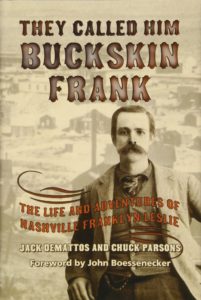 They Called Him Buckskin Frank, Jack Demattos an Chuck Parsons, University of North Texas Press, $29.95, Cloth, Photos, Notes, Bibliography, Index.
They Called Him Buckskin Frank, Jack Demattos an Chuck Parsons, University of North Texas Press, $29.95, Cloth, Photos, Notes, Bibliography, Index.
The name Buckskin Frank Leslie seems always to appear in the old Tombstone stories. Doc Holliday the Earps, Johnny Ringo and some others had some association with him, but he was always on the “fringe.” (No pun intended.) He was tagged with the name “Buckskin Frank” probably because he nearly always wore a buckskin jacket.
The reality was that he handled guns, sometimes rode with the sheriff, scouted for the Army during the Geronimo campaign, and owned saloons in Tombstone. He was notorious for having shot and killed his girlfriend but never really became a major figure in the Tombstone story we have seen in countless movies and television shows.
The authors of this book have sorted through the wild tales and incomplete history of Buckskin Frank, but information such as exactly where he was born, and parental history remain vague. He claimed to be college educated, and this may very well be true. A long letter he wrote for a San Francisco newspaper in 1900 detailing his participation in trailing Apaches is extremely well-written. This alone shows he was probably educated beyond the usual Tombstone cowboys of that time.
Buckskin Frank was short in statue, but handsome nonetheless, able to attract the ladies in droves. He had a long list of girlfriends, lovers and wives. He shot and killed the husband of one of his future wives, he left others in divorce court or simply vanished when convenient. One lady scheduled to be his wife was left quite dead as a result of the business end of his shootin’ iron after a drunken brawl at his ranch near Tombstone. Her grave marker in the Arizona desert says “Mollie Williams”, but her real name was Mollie Edwards. The result of her death sent Buckskin Frank to Yuma Territorial prison for eight years.
He was a model prisoner, put in charge of the prison pharmacy, and was released early due to his good behavior on November 17, 1896. He was met at the prison gates by a love-sick widow whom he married fifteen days later. After promising her a honeymoon trip to China, he dumped her in April. Apparently China was the farthest thing from his mind.
He spun some good yarns about himself, which got mixed up with reality thus making it difficult for biographers to sift through the information, real and otherwise.
For instance he claimed to have been a scout for General George Armstrong Custer, but no military records can be found giving proof of this. He did scout during the Geronimo Campaign in Arizona, having gone deep into Mexico hunting for runaway Apaches. He did kill several men in gunfights, and he was involved in the Spanish American War in Cuba.
The authors have trailed Buckskin Frank to San Francisco where he continued to move from one house to another, frequented billiard parlors and saloons, had mining interests South of the Border, and eventually in his old age disappeared all together. It is suggested he was the victim of foul play, complete with skeletal remains, outside Oakland, California.
This book is enchanting, putting some old fictionalized tales regarding Buckskin Frank to rest, but also pointing to some new and tantalizing information about the man. Buckskin Frank’s life was certainly filled with unusual adventures. Gambler,
Who really was Buckskin Frank Leslie? This book is a fascinating read.
Editor’s Note: The reviewer Phyllis Morreale-de la Garza is the author of numerous books about the Old West including Death For Dinner, The Benders of (Old) Kansas, published by Silk Label Books, P.O. Box 399, Unionville, New York 10988 www.siIklabelbooks.com
*Courtesy of Chronicle of the Old West newspaper, for more click HERE.
Old West Book Review: Butch Cassidy My Uncle
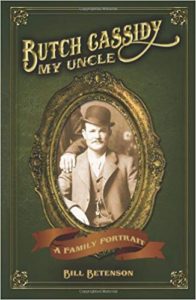 Butch Cassidy My Uncle, Bill Betenson, High Plains Press (1-800-552-7819), $1995, Paperback. 300 pages, Photographs, Notes, Bibliography, Index.
Butch Cassidy My Uncle, Bill Betenson, High Plains Press (1-800-552-7819), $1995, Paperback. 300 pages, Photographs, Notes, Bibliography, Index.
Back in the 1960s, most of us who love western movies went to see a flick called Butch Cassidy and the Sundance Kid. Paul Newman and Robert Redford played the important roles, and we came away impressed and intrigued having seen a cowboy movie we were told was based on facts.
Butch and Sundance were real, and most of their exploits have been delved into now that Hollywood brought the pair to light. So much has been written and told about Butch Cassidy, that one family member Bill Betenson, the great-grandson of Butch’s youngest sister, decided to try to set the record straight. Butch Cassidy came from a large and mostly law-abiding family. Except for one uncle, Dan Parker, who spent time in the Detroit House of Corrections for holding up a store, the rest of the Parkers were embarrassed by Butch’s outlawry.
This book begins with the early life of Butch, whose real name was Robert LeRoy Parker, telling of his youth, schooling and employment. Betenson has access to family memorabilia, plus he has done an admirable job of searching through historical documents, newspaper articles, and public records as well as visiting many of the places where Butch lived.
Butch (a nickname he acquired after working as a butcher), seemed easily attracted to life on the wild side. He did have real jobs in ranching and mining, and his employers always spoke highly of his good manners and careful attention to his duties. But he was also intrigued with adventure and easy money. At various times he took up with characters of questionable integrity, and was therefore involved in a variety of robberies. He rode with a gang holed up in the wilds of Utah. Robbing banks, stagecoaches, trains and even horse rustling were the usual endeavors. Butch spent most of his adult life hunted by sheriff’s posses, cavalry units and detectives working for Pinkertons
This book is filled with family photos and various scenes from Butch’s past, including images of his friends and relatives, besides members of the gang when he hooked up with Harry Longabaugh, (the Sundance Kid). Butch traveled with Sundance and a variety of other gang members, even going as far away as New York City, joined by an attractive young woman known as Ella Place. Butch, Sundance and Ella finally drifted to South America where authorities in the United States continued to hunt them. They wound up in Argentina, and even bought a cattle ranch where they planned to start anew. But alas the Pinkertons and other law enforcement people seemed always lurking nearby.
Again the trio got involved in bank robberies, and conflicting reports has them either killed in South America, or having gotten away due to some other American outlaws killed by police, being mistakenly identified as Sundance and Butch. This of course led to all the modern day controversy. Did Butch die in South America? Did he really come home years later as some of his friends and relatives insist? It has long been told, even in the movie, that Butch and Sundance died in a hail of lead in South America after they robbed a bank. However, there is a strong case told here that while Sundance may have died there, Butch survived and returned years later to the United States.
The last chapter of the book delves into all of the available information the author has gleaned pointing to Butch’s return. The author writes an intriguing account in a forthright manner without trying to sway the reader’s opinion one way or the other. This book is a treasure of factual information about the life and times of Butch Cassidy, and most likely the best written so far. It’s another good one from High Plains Press.
Editor’s Note: The Reviewer, Phyllis Morreale-de la Garza is the author of many published books, including the novel Nine Days at Dragoon Springs, published by Silk Label Books, P. 0. Box 700, Unionville, New York 10988 (845-726-3434) www.silklabelbooks.com.
*Courtesy of Chronicle of the Old West newspaper, for more click HERE.
I See By Your Outfit, Historic Cowboy Gear of the Northern Plains
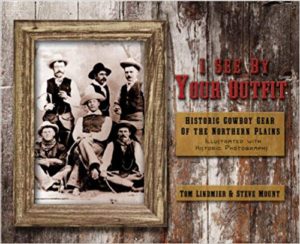 I See By Your Outfit, Historic Cowboy Gear of the Northern Plains, Tom Lindmier & Steve Mount, High Plains Press, Glendo, Wyoming. $19.95, Paperback. Photos, Illustrations, Bibliography, Index.
I See By Your Outfit, Historic Cowboy Gear of the Northern Plains, Tom Lindmier & Steve Mount, High Plains Press, Glendo, Wyoming. $19.95, Paperback. Photos, Illustrations, Bibliography, Index.
Here is yet another non-fiction winner published by High Plains Press. Authors Tom Lindmier and Steve Mount have joined forces, writing a wonderfully accurate book filled with information about what real cowboys of the late 1800s looked like and wore on the American Northern Plains.
Every bit of clothing is described, from hats to boots, including favorite equipment used with their horses. Saddles, bits, bridles and spurs, ropes, saddle blankets and more fill these pages. Readers find a list of names of providers of clothing and horse equipment like Montgomery Ward, Sears, Roebuck, and Porter Saddle and Harness Company appear, including the prices. Additionally, the authors have not forgotten the guns. Every type of shootin’ iron the old-time cowboys used are pictured and discussed. Names like Spencer, Sharps and Winchester fill the chapter on revolvers and rifles.
The book is filled with original photographs showing cowboys wearing shotgun chaps, mohair “woolies”, and batwings. Most men wore vests, a garment practical for all weather besides having pockets to stuff watches and other valuables. You won’t see fancy Stetsons, but a different shaped, mostly-flat brimmed hat meant to resist gusty winds. It was known as “Boss of the Plains” and looked nothing like the hat Roy Rogers wore. The book explains how the cowboy clothing and horse gear was mostly meant for practicality rather than rodeo flair. These cowboys needed jeans, shirts and gloves to protect them from all the harsh elements from saddle sores to rope burns. Spurs were meant to keep a horse alert to sudden starts, and bits with rollers and chains had their practical uses, too.
Page after page keeps the reader intrigued with good information as well as some personal letters written by the cowboys themselves as they told about life on a cattle drive. The many photographs are particularly intriguing showing the men at work, or sitting on the ground beside a campfire. Near the chuck wagon stands a sullen cook wiping his hands down his greasy apron while a cigarette dangles from his lip. (This leaves you wondering what may have fallen into the stew.) The dust, the campfire smoke, the rough and ready cows and horses are all pictured here.
The chuck wagon was home. Pots, pans, Dutch ovens, water barrels and stacks of coffee, flour, sides of bacon, beans, sugar, dried apples and peaches, plus rice made up the load. There were canned tomatoes mixed with the emergency medical supplies. Chuck wagons and how they operated is explained, while another vehicle called a “bed wagon” was included in the roundups, but is seldom seen in movies. This wagon carried the cowboy’s gear…blankets and bedrolls, and other personal items necessary for the long trips.
Readers learn something new with every page, the old-time pictures are marvelous. Some studio photos the cowboys had made of themselves shaved and clipped gives us a glimpse of their showoff side, too.
Several of the pictures taken on the range show Nate Champion, a hero of the Johnson County War. Nate, a brazen tough-guy who stood up to the big ranchers, was murdered by a gang of Texas gunslingers for hire. Nate’s tragic story is told elsewhere, but he’s shown right here in the middle of things, riding with his pals reminding us what a real western hero was all about.
Whether you are reading for fun, or a serious writer/researcher working on an old-west project requiring authenticity, this is the book for you.
Publisher’s Note: The reviewer, Phyllis Morreale-de Ia Garza is the author of numerous books about the Old West including Death For Dinner, the Benders of (Old) Kansas, published by Silk Label Books, P.O. Box 399, Unionville, New York 10988. www.silklabelbooks.com
Old West Book Review: The Hog Ranches of Wyoming; Liquor, Lust and Lies
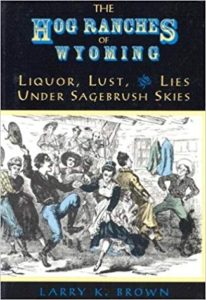 The Hog Ranches of Wyoming; Liquor, Lust and Lies Under Sagebrush Skies, Larry K. Brown, High Plains Press, (800-552-7819) $9.95, Paperback.
The Hog Ranches of Wyoming; Liquor, Lust and Lies Under Sagebrush Skies, Larry K. Brown, High Plains Press, (800-552-7819) $9.95, Paperback.
When the comment is made by those who know little about the Old West, “The Wild West is a Hollywood myth,” I always chuckle. I can’t imagine life getting much wilder than at the “Hog Ranches” that appeared near almost every military fort on the old frontier. Whiskey, women, card games, shoot-outs, music and murder were all part of these establishments built for the express purpose of separating lonely soldiers, wayward frontiersman and even cowboys from their wages.
This book centers around those infamous establishments far from law and order where good guys, bad guys, lawmen, cowpokes, soldiers and highwaymen gathered for a good old time. The author has sifted through newspaper articles, court documents, letters and census records, Military Post Returns, and diaries for the facts regarding some Wyoming Hog Ranches we don’t usually read about in history books.
The origin of the name “Hog Ranch” suggests a certain unpleasantness about the property, but it is pointed out while hogs were sometimes raised here, the name probably referred to the lowdown characters who inhabited these walls. How the name came to be has never been entirely proven, but what has been proven are the illicit activities that drew lonely people to these dens of iniquity. Here they found camaraderie and enjoyed the crude buildings, rustic furniture, out-of-tune pianos, earthen floors, missed spittoons and mortal injuries that sometimes ended the careers of those who paid their money and took their chances.
With names like “Bad Man Charlie Anderson’s Hog Ranch”, and “Six Mile Hog Ranch”, they were visited by members of the Wild Bunch and even Alfred Packer, the notorious cannibal who had escaped from prison after dining on at least seven of his fellow travelers during a snow storm in the Rockies.
To say the characters found at these places were dangerous, is putting it mildly. Calamity Jane worked for a time at the Six Mile Hog Ranch. She is pictured in the book dressed in garb once worn by her military customers. Calamity stares back at the camera while showing off a big pistol on her hip. Other stories include women who helped their husbands run the saloons at these ranches and tell how they cheated customers when selling drinks. One interesting character was “Old Mother Featherlegs” who ran her place of entertainment on the Cheyenne-Black Hills stage route in 1876. The lady was said to have flowing red hair and wore a pair of long red pantalettes. When riding horseback, she was compared by a local wag to a “feather-legged chicken in a high wind.” In cahoots with some local road agents, Featherlegs hid their stolen money under her shack, but got mixed up with a trapper nicknamed “Dangerous Dick” who eventually murdered her for the dough. Her body was found shot in the back; Dick’s moccasin prints were recognized nearby.
Murder, shoot-outs, venereal disease and double-cross were all part of the game people played when they associated with the hog ranches. Tragedy struck in other ways as was evidenced by the tiny graves on nearby hillsides where some soiled doves buried children born here. Cold, snow, dust and disease were all part of the desolate lifestyle known to these girls.
Some of the stories related here are humorous, some are harsh and sad. This book is only 120 pages in length, but is filled of interesting material including photographs of some buildings, a few felons, a couple of sheriffs, and a peek into the wild side of life on the Old Frontier.
Grab a copy HERE.
Editor’s Note: The reviewer, Phyllis Morreale de la Garza is the author of numerous books including Wild Women of the Old West, published by Silk Label Books, P.O. Box 700, Unionville, New York 10988-0700 (845) 726-3434
*Courtesy of Chronicle of the Old West newspaper, for more click HERE.
Old West Book Review: The Mysterious Private Thompson
 The Mysterious Private Thompson, Laura Leedy Gansler, Free Press a Division of Simon & Schuster, Inc., $25.00, Hardcover.
The Mysterious Private Thompson, Laura Leedy Gansler, Free Press a Division of Simon & Schuster, Inc., $25.00, Hardcover.
It is not unusual for women to become soldiers in our day and age, but back in the 1860s, it was shocking to think a girl would don men’s clothing, cut off her hair, change her name and join the Union Army.
This is the fascinating story of Emma Edmonds, born in New Brunswick, Canada in 1841. The last of six children, five of whom were girls, Emma grew up on a hard-working farm in a remote wilderness with a father who let it be known he wanted sons. In an effort to please her father, Emma learned to ride and shoot, follow a plow, split logs and work in the fields like a man to please her pa. However, she was never quite good enough. The girl developed a deep resentment toward men, read lots of books, and dreamed of becoming a missionary. She finally ran away from home at seventeen when her father tried to marry her off to an elderly, newly widowed neighbor with a passel of children who needed a mother.
Hiding in the back of a carriage while her father was in the fields, Emma made her escape. She worked briefly in a millinery store in town but feared her father would find her. Desperate not to be dragged back to the farm, Emma hacked off her hair, dressed as a boy, and dared to answer an ad in an American newspaper advertising for help as a subscription salesman and book agent in the vicinity of Hartford, Connecticut. Practicing masculine walk and talk, Emma ventured to the United States and got the job. Having changed her name to Frank Thompson, she embarked on this daring lifestyle, always careful not to become too friendly with anyone who might discover the truth.
Cherishing her freedom as a man, she became a successful book salesman, continually moving about and even enjoying a few “dates” to keep up appearances. By 1860, with Civil War looming, Emma got caught up in the excitement of North vs. South, and vowed to perform her duty. She enlisted in the Union Army as a member of the Michigan Brigade. Fortunately for her, physical examinations during those early days consisted of mere questioning by the military doctors to determine a recruit’s health.
It has been estimated that between 250 and 500 women disguised themselves as men to fight in the Civil War, so Emma was hardly the only woman to do this. Nevertheless, Emma, now known as Frank Thompson, knew she would not like to carry a gun so she volunteered to work in the field hospitals. This turned out to be easy since most recruits shied away from the ghastly chores associated with assisting battlefield doctors under crude field conditions. Too, among her duties, she became a mail courier since she was lighter than most men and excelled in riding horses at a quick pace over long distances.
The book tells about battles fought, Emma’s spy escapades, her falling in love with a fellow soldier, her desertion and ultimate return to life as a civilian female.
The author of the book, Laura Leedy Gansler follows Emma all the way to her life in Kansas where she applied for her military pension, wrote about her escapades, and surprised her fellow soldiers-in-arms when they discovered the courier and hospital attendant they knew during Civil War days was really a woman. Even after Emma became a married woman with children, she wore pants around town, rode her horse astride, and was known as an eccentric who did not care what her neighbors thought of her. Mrs. S.E.E. Seelye of Fort Scott, Kansas had never been one to worry about wagging tongues. That said, you can get this amazing book HERE.
Editor’s Note: The Reviewer, Phyllis Morreale-de la Garza is the author of many published books, including Silk and Sagebrush: Women of the Old West, published by Silk Label Books, P.O. Box 700, Unionville, New York 10988 (845-726-3434) www.silklabelbooks.com
*Courtesy of Chronicle of the Old West newspaper, for more click HERE.
Old West Book Review: Charles M. Russell: Printed Rarities from Private Collections
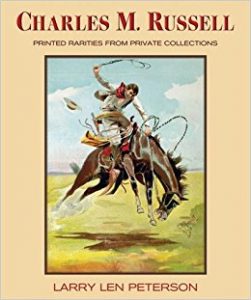 Charles M. Russell: Printed Rarities from Private Collections, Larry Len Peterson, Mountain Press Publishing Co., (800-234-5308),74 black-and-white images, 35 historical photographs, Index, Cloth $70, Paper $45.00.
Charles M. Russell: Printed Rarities from Private Collections, Larry Len Peterson, Mountain Press Publishing Co., (800-234-5308),74 black-and-white images, 35 historical photographs, Index, Cloth $70, Paper $45.00.
This magnificent book, filled with dozens of Charles M. Russell Western images, tells the story of a modest man who came to be one of the most famous artists of the American West.
Charles Marion Russell was born March 19, 1864 in St. Louis Missouri. The third of six children, Charlie’s early life was one of financial security. He wanted for nothing, and his father expected the boy to become a businessman. However, Charlie chose to spend his time riding horses, reading dime cowboy novels, and drawing pictures. Determined to go “Out West”, Charlie convinced his father to send him to Montana on his sixteenth birthday. The boy traveled by train, then stagecoach and wound up on a Montana sheep ranch owned by a family friend. Charlie’s father was sure his son would sour quickly from this experience, but Charlie fooled him. For the next fifteen years the young man worked at various ranches; horses and cattle became his way of life. Meanwhile, he continued sketching pictures of horses, cattle, Indians, and the wilderness around him. He carried wax in his pockets, and when not sketching, he modeled little figurines he gave away to friends.
Charlie Russell admitted he was not a good businessman. He wanted to earn his living as an artist, but he often gave his drawings away. Too embarrassed to ask a fair price for his pictures, he barely eked out a living.
That all changed in 1896 when he married Nancy Cooper, a seventeen-year-old who had been abandoned by her stepfather. When Nancy’s mother died in 1894 of tuberculosis, Nancy went to work as a housekeeper for a family in Cascade, Montana where Charlie rented a small artist’s studio. Nancy was Charlie’s most loyal fan, determined that his artwork should bring a fair price. Nancy stood by her man, driving hard bargains, promoting Charlie’s artwork, and eventually hiring lawyers, if necessary, to draw up contracts and make important business deals.
They traveled, built a new home and artist studio, and took trips while Charlie enjoyed celebrity status during his lifetime. The Russells had no children, but adopted a boy they named Jack whom they spoiled and adored. During his lifetime, Charlie’s friends included such notables as screen star Harry Carey and political humorist Will Rogers with whom he spun many yarns. Charlie Russell loved to tell funny stories, had a great sense of humor and while he did not drink alcohol, spent many an evening “swapping windies” with his old cowboy buddies at the local saloons.
In his old age he suffered from gout, together with breathing difficulties due to his years of chain smoking. Charlie Russell died of heart failure on October 24, 1926 in Great Falls, Montana. The “Cowboy Artist” was buried at the Highland Cemetery in Great Falls on a day when all businesses and schools in that community closed in his honor.
His widow lived another fourteen years until dying of a heart attack in 1940.
Nancy spent all of her remaining fourteen years promoting Charlie’s work, and finalizing the disposition of his estate. Much of his artwork including his sculptures are today found in museums throughout the United States.
This book contains images of famous paintings, as well as rare sketches commissioned to appear on advertising trays, phony money, menus, stationery, business flyers, Western novels, rodeo flyers and calendars. Charlie Russell’s artwork is known for its authenticity depicting ornery broncs, marauding Indians, killer snow storms, bawling cattle, howling wolves and buffalo hunters. This book makes a wonderful gift, or a treasured keepsake for your Old West library. You can get it HERE.
Editor’s Note: The reviewer, Phyllis Morreale-de la Garza is the author of fourteen published books about the Old West including The Apache Kid, published by Western lore Press, P.O. Box 35305, Tucson, Arizona 85740
*Courtesy of Chronicle of the Old West newspaper, for more click HERE.


